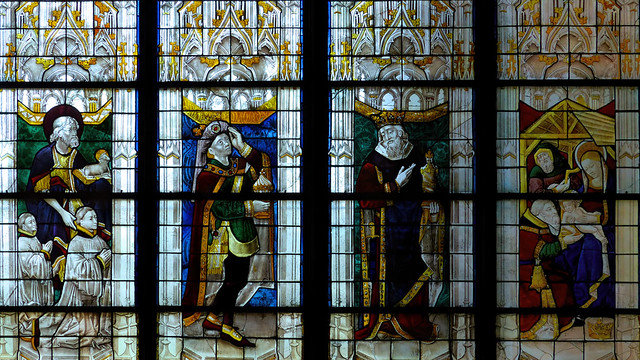Adoration of the Magi - Bourges Cathedral

This window depicts the Adoration of the Magi, one of the most accomplished surviving examples of mid-15th-century glass painting in Bourges Cathedral. The composition unfolds across four lights beneath a framework of delicate Gothic canopies enriched with gilded tracery and pinnacles.
At the far right, the Virgin and Child are shown within a rustic stable attended by Saint Joseph, while the three Magi approach from the left bearing their gifts of gold, frankincense, and myrrh. The eldest kneels in reverence before the Child, while the younger kings stand behind, one lifting his crown in homage. Two youthful attendants, possibly representing donors or pages, kneel in devotion to the far left.
The modelling of the figures is exceptionally refined, marked by supple drapery folds, expressive faces, and a subdued but rich palette dominated by deep blues, rubies, and greens. The upper tracery and architectural framing employ elaborate crockets and finials, executed in silver stain and yellow enamel, characteristic of the Flamboyant Gothic idiom.
Stylistic and Historical Context
The window is dated 1467, a period of artistic renewal at Bourges following the turbulence of the Hundred Years’ War. By this time, the cathedral workshops were flourishing under royal and episcopal patronage, producing a series of narrative windows that bridge the Late Gothic and early Renaissance styles.
Although unsigned, this glass is attributed on stylistic grounds to the Bourges Cathedral workshop, possibly under the direction of Jean Lécuyer or André Robin, both documented as maîtres verriers active at Bourges between 1460 and 1470. The treatment of faces, the volumetric modelling, and the compositional structure show close affinities with the glazing of the Chapelle Saint-Guillaume and the Église Saint-Pierre-le-Puellier in Bourges, both associated with this circle.
The figures display a subtle realism and psychological depth rare in mid-15th-century French glass, suggesting the influence of Netherlandish painting and the growing humanism of the Loire–Berry school. The canopies, by contrast, preserve the intricate linearity of the Flamboyant Gothic, creating a tension between ornamental complexity and emerging spatial clarity.
Condition
The glass remains in an excellent state of preservation, with most of its original paintwork intact. Minor releading and cleaning were undertaken during the 19th-century restoration campaigns at the cathedral. The intensity of the pot-metal colours and the luminosity of the silver stain remain remarkably fresh.
Summary
The Adoration of the Magi window at Bourges Cathedral, executed in 1467 by the Bourges Cathedral workshop, represents a pinnacle of mid-15th-century French stained glass. Combining the decorative richness of the Flamboyant Gothic with the naturalism and psychological sensitivity of the early Renaissance, it reflects the high technical and artistic standards of the Jean Lécuyer–André Robin circle, one of the most influential glazing ateliers of the Loire and Berry regions during the reign of Louis XI.
